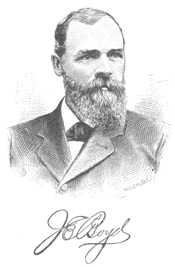


The Boyd County, Nebraska research page is proud to be part of the USGenWeb and NEGenWeb projects.
The USGenWeb project consists of a group of volunteers, working together to provide Internet websites for genealogical research in every county and every state of the United States. This project is non-commercial and fully committed to free access for everyone.
This site provides a location where new volunteers can find answers to many of the questions they have about the USGenWeb Project. Where help is needed, guidelines for county and state websites, etc. It also provides information that coordinators can review on subjects that may come up after they establish their state, county or town website. Please help out by adopting a county today!
Copyright © 2001 Pamela R. Roy
Any information found here within this page may be used freely by fellow genealogists. Any commercial use or posting of pages without consent of the author/host of these pages is prohibited.
Page Creation: July 3, 2001
|
|
|
Boyd County, Rosedale, Bristow, Anoka, and Kinkaid
Submitted and copyrighted by Wade Anderson ©.
Boyd County, Nebraska, and Gregory County, South Dakota included Sioux and Ponca Indian lands extending as far south as the Niobrara River. In 1875 Gregory extended into northern Nebraska, with the Keya Paha River as boundary. On 4 February 1890 the eastern quarter of Gregory ceded by the Sioux in 1889 to the US was opened to homesteading. This territory included parts of Nebraska but not the (96,160 acre total in SD+NE - 38915 hectare) Fort Randall Military Reserve. The Indians were given six months to make selections for their homes and most of them went to Gregory County. Boyd was officially proclaimed a county 01 August 1891.
That autumn, the first school at Rosedale (Rosedahl, Rosendahl) community, Bristow, was built; in 1905 Rosedale was discontinued as a town due to the postal rural route being started out of Spencer NE. Ft. Randall SD disbanded in 1892 and opened for settlement (Gross NE area) 03 March 1893. In 1894 the first portion of the Gregory Co. border was defined two miles west of Bonesteel; it had been attached to Charles Mix County SD for judicial purposes. In 1895 homesteaders and squatters were allowed to file in Gregory County. The southeast corner of Gregory extended into Boyd and Keya Paha Counties, politics having marched this border ever northward until the “Three Mile Strip” (table land between Ponca Creek and the Niobrara River breaks - known as Baker Flats) came into being. Deeds from properties only two miles north of Spencer still show 'Dakota Territory'; the post office for Bristow opened January 1891 was considered to be in Todd Co. SD; in March, it was changed to Boyd. The first settlers in this area did not know whether they were in Nebraska or South Dakota, as it was not definitely decided where the state line would be until 1895, when it was first surveyed. The original Turtle Creek precinct was the territory between the Keya Paha and Niobrara rivers in western Boyd county; it was a part of Holt Co. NE and was settled before the rest of Boyd. The part of the 27,000 acre Ft. Randall Military Reservation in Nebraska was bounded by the Military Line which ran northwest to southeast parallel to the Missouri River - from section 3, township 35, range 10 diagonally southwest to section 31 T34 R11, then diagonally north to section 21 T35 R12. An 1889 railroad map of South Dakota shows this Military Reserve at one point 3½ miles west of Gross, taking all but the extreme southwest corner of range 11 in Nebraska, and the northeast corner of 12.
Baker (in Ware Twp.), about 7 miles east and one to two miles north of Anoka, ½ mile south of South Dakota, began 24 Nov 1891 when Leonard C. Baker established a post office in the southeast corner of his W½ Section 35 Star Valley Twp., Gregory Co. (an area surrounded by a lake bed; this southeast 80 included Baker itself - Baker was located at the first crossroad, 2 miles southwest of the, as of 1981, Bait Station, east of Fairfax SD; Baker Corner). Its name changed to “New” Baker (Dakota Territory) 02 Feb 1895 and back to Baker, Boyd Co. 20 Dec 1895. In 1896 the post office was moved 1¼ miles south so that it would be in Nebraska (T35 R12 Sec 21). The first telephone was in the summer of 1899. Baker had 2 stores, a blacksmith and a hardware shop, livery barn, lumberyard, baseball field (north, and north of it, Baker Cemetery), dance hall, hotel, saloon, and 3 churches; Messiah Evangelical Lutheran, Baptist (organized 1890-1, discont. about 1906; 1½ miles west of Baker / seven miles southeast of Fairfax, in Star Valley Twp., a building then or sometime soon thereafter, perhaps ca. 1901, dissolved ca. 1906-07; about 1.5 miles W, 1 mile N of Baker ), and St. Joseph's Catholic Church (built 1900-01, with parochial school closed 01 Oct 1951, located 42ø59'19"N 098ø43'58"W). Baker incorporated in 1902 consisting of a 4-mile square, later that year reduced to 80 square rods (½ acre). The post office closed 02 Apr 1906, the last store in 1908. Baker ceased 1916, the only building left of the town itself was the hotel. Remnants of other town buildings were used by some of the remaining early settlers on their nearby farms. By 1931 there remained the Catholic and Lutheran churches, the baseball diamond, and the Baker and nearby Old Settler's cemeteries.
Baker's demise (like that of nearby Gross and Kinkaid, see below, and later, in similar fashion, Carter, Tripp Co. SD) was impacted by the fact that the Fremont, Elkhorn & Missouri Valley Railroad (FE&MV, consolidated 01 March 1903 into the Chicago and Northwestern, C&NW) announced in December of 1901 that work on the "Bonesteel Extension" would commence in early 1902 and that this largely granger line would be built to Lynch, Spencer, and the Butte area (Anoka) during that summer. The railroad bypassed Baker by following the Ponca Creek up from Spencer to Anoka, where it left the Ponca Valley and climbed the divide between Ponca Creek and the Missouri River. (Surveys in 1901 had considered a line from Lynch up "Whiskey" Creek to the Kinkaid settlement near Gross, about seven and one-half miles northwest of Bristow, and then across the ridge towards Baker and on to Fairfax SD).
Anoka , (in Butte Twp.) an Indian word meaning “on both sides”, in this case, alongside Ponca Creek, was named by the Pioneer Town Site Co. after Anoka MN. The school district was organized in 1893 and formalized 16 February 1900. The village of Anoka was organized in 1903, and soon had a weekly newspaper (Anoka Herald, 1904), 2 grain elevators, hotel, bank, livery stable, a general, a hardware, and a drug store, lumber yard, and barber shop. By 1905 Anoka had 31 businesses. A school including 2 upstairs and 2 basement rooms was built in 1905 about 1½ miles northwest and stood until c 1994 when it was sold and moved to a nearby farm. In 1910 the Presbyterian church was purchased and moved west of nearby Butte. A Baptist congregation organized 18 Jan 1904; it came to include a frame church, small parsonage and barn; it disbanded latest by 1911. The first water system was installed c 1915.
Kinkaid was a townsite laid out in 1901 by the Kinkaid Townsite Co., of Lynch, John A. Lynch and Stephen W. Lightner, being resp. President and Secretary, on information that the railroad would leave the Ponca valley at Lynch and then through that place. A plat was made by A. H. Sargent, C. E., and filed 29 April 1901, for the northwest quarter of Section 8, Township 34, Range 11. Anton Holechek was also involved with Mr. Lightner. On 18 March 1903 Messrs. Lynch and Lightner filed a vacation of the plat. They had at that time sold no lots. The land was afterward sold to W. T. Wills as a farm. The land was about seven and one-half miles northwest of Bristow, near Gross, and close to School District #77, a bit south of where the schoolhouse stood (at least as of the late 1930s), and $20,000 as capital stock was used in its development. It consisted of a post office, a store and a lumber yard, and the foundation of a hotel.
Return to the Boyd County NEGenWeb Project Main Page
|
|


